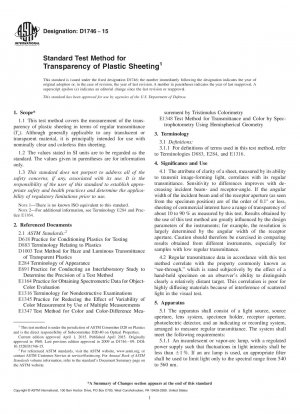ASTM D1746-15
Standard Test Method for Transparency of Plastic Sheeting
- Standard No.
- ASTM D1746-15
- Release Date
- 2015
- Published By
- American Society for Testing and Materials (ASTM)
- Status
- Replace By
- ASTM D1746-23
- Latest
- ASTM D1746-23
- Scope
4.1 The attribute of clarity of a sheet, measured by its ability to transmit image-forming light, correlates with its regular transmittance. Sensitivity to differences improves with decreasing incident beam- and receptor-angle. If the angular width of the incident beam and of the receptor aperture (as seen from the specimen position) are of the order of 0.1° or less, sheeting of commercial interest have a range of transparency of about 10 to 908201;% as measured by this test. Results obtained by the use of this test method are greatly influenced by the design parameters of the instruments; for example, the resolution is largely determined by the angular width of the receptor aperture. Caution should therefore be exercised in comparing results obtained from different instruments, especially for samples with low regular transmittance.
4.2 Regular transmittance data in accordance with this test method correlate with the property commonly known as “see-through,” which is rated subjectively by the effect of a hand-held specimen on an observer's ability to distinguish clearly a relatively distant target. This correlation is poor for highly diffusing materials because of interference of scattered light in the visual test.
1.1 This test method covers the measurement of the transparency of plastic sheeting in terms of regular transmittance (Tr). Although generally applicable to any translucent or transparent material, it is principally intended for use with nominally clear and colorless thin sheeting.
1.2 The values stated in SI units are to be regarded as the standard. The values given in parentheses are for information only.
1.3 This standard does not purport to address all of the safety concerns, if any, associated with its use. It is the responsibility of the user of this standard to establish appropriate safety and health practices and determine the applicability of regulatory limitations prior to use.
Note 1: There is no known ISO equivalent to this standard.
Note 2: For additional information, see Terminology E284 and Practice E1164.
ASTM D1746-15 Referenced Document
- ASTM D1003 Standard Test Method for Haze and Luminous Transmittance of Transparent Plastics
- ASTM D618 Standard Practice for Conditioning Plastics for Testing
- ASTM D883 Standard Terminology Relating to Plastics
- ASTM E1164 Standard Practice for Obtaining Spectrophotometric Data for Object-Color Evaluation
- ASTM E1316 Standard Terminology for Nondestructive Examinations
- ASTM E1345 Standard Practice for Reducing the Effect of Variability of Color Measurement by Use of Multiple Measurements
- ASTM E1347 Standard Test Method for Color and Color-Difference Measurement by Tristimulus (Filter) Colorimetry
- ASTM E1348 Standard Test Method for Transmittance and Color by Spectrophotometry Using Hemispherical Geometry
- ASTM E284 Standard Terminology of Appearance
- ASTM E691 Standard Practice for Conducting an Interlaboratory Study to Determine the Precision of a Test Method
ASTM D1746-15 history
- 2023 ASTM D1746-23 Standard Test Method for Transparency of Plastic Sheeting
- 2015 ASTM D1746-15 Standard Test Method for Transparency of Plastic Sheeting
- 2009 ASTM D1746-09 Standard Test Method for Transparency of Plastic Sheeting
- 2003 ASTM D1746-03 Standard Test Method for Transparency of Plastic Sheeting
- 1997 ASTM D1746-97 Standard Test Method for Transparency of Plastic Sheeting
